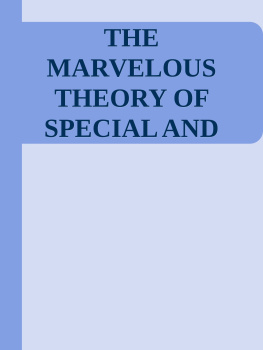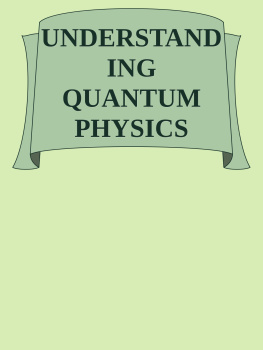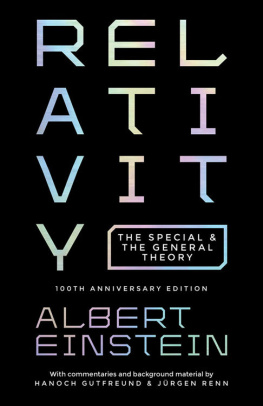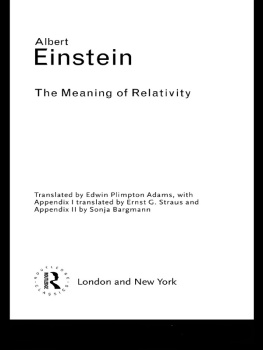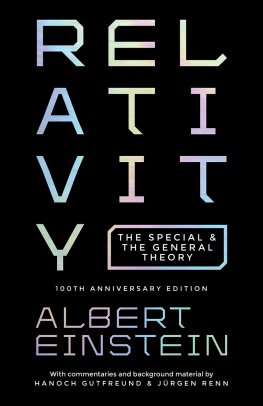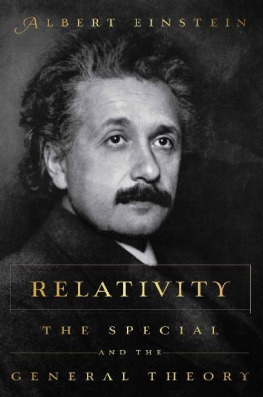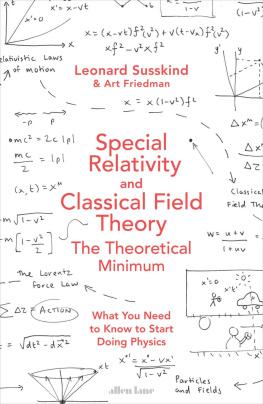umberto piacquadio - THE MARVELOUS THEORY OF SPECIAL AND GENERAL RELATIVITY
Here you can read online umberto piacquadio - THE MARVELOUS THEORY OF SPECIAL AND GENERAL RELATIVITY full text of the book (entire story) in english for free. Download pdf and epub, get meaning, cover and reviews about this ebook. year: 2019, genre: Romance novel. Description of the work, (preface) as well as reviews are available. Best literature library LitArk.com created for fans of good reading and offers a wide selection of genres:
Romance novel
Science fiction
Adventure
Detective
Science
History
Home and family
Prose
Art
Politics
Computer
Non-fiction
Religion
Business
Children
Humor
Choose a favorite category and find really read worthwhile books. Enjoy immersion in the world of imagination, feel the emotions of the characters or learn something new for yourself, make an fascinating discovery.
- Book:THE MARVELOUS THEORY OF SPECIAL AND GENERAL RELATIVITY
- Author:
- Genre:
- Year:2019
- Rating:5 / 5
- Favourites:Add to favourites
- Your mark:
- 100
- 1
- 2
- 3
- 4
- 5
THE MARVELOUS THEORY OF SPECIAL AND GENERAL RELATIVITY: summary, description and annotation
We offer to read an annotation, description, summary or preface (depends on what the author of the book "THE MARVELOUS THEORY OF SPECIAL AND GENERAL RELATIVITY" wrote himself). If you haven't found the necessary information about the book — write in the comments, we will try to find it.
THE MARVELOUS THEORY OF SPECIAL AND GENERAL RELATIVITY — read online for free the complete book (whole text) full work
Below is the text of the book, divided by pages. System saving the place of the last page read, allows you to conveniently read the book "THE MARVELOUS THEORY OF SPECIAL AND GENERAL RELATIVITY" online for free, without having to search again every time where you left off. Put a bookmark, and you can go to the page where you finished reading at any time.
Font size:
Interval:
Bookmark:
THE
MARVELOUS THEORY OF
SPECIAL AND
GENERAL RELATIVITY
Written by Umberto Piacquadio
Translated by Giulia Carcaterra
copyright Ed 2019 by Umberto PiacquadioNo part of this publication may be reproduced, stored in a retrieval system ortransmitted in any form or by any means, electronic, mechanical, photocopying,recording or otherwise without the prior permission of the author.
info

INDEX
On May 29, 1919, the English astronomer Sir Arthur Eddington musthave jumped when, while observing a total eclipse of the sun,discovered that the man, who four years earlier had published thecontroversial theory of General Relativity, had been right.
We are talking about one of the most famous physicists of history:Albert Einstein. His career as a great scientist had begun in 1905
when, by a half-known employee of the patent office in Bern as hewas, he published his first two articles regarding the Special Relativity.
I am going to introduce the reader to the restricted and generalTheory, which is the theme of this work, without too many scientificclaims. However this topic can not be fully grasped without themathematical and physical bases gained in high school.
I will try to explain the restricted and general Theory with an innovativeapproach, different from many other educational treatises, which oftenneglect the mathematical aspects necessary for a correctunderstanding of this subject. On the contrary I am going to teach thistopic through rigorous mathematical demonstrations, graphs anddiagrams.
After a brief but indispensable historical and biographical introductionon Albert Einstein, I have paid particular attention to the idea ofRelativity, already present in Galileo's observations. Furthermore Ihave exposed the main works of James Clerk Maxwell, AlbertAbraham Michelson, Edward Morley, and Hendrik Antoon Lorentz inorder to reach the absolutely innovative idea postulated by the Theoryof Special Relativity. Once immersed in this new theory, in the secondchapter I analyzed the concepts about the times dilation and thedistances contraction from an analytical point of view concluding with asolution to this fascinating paradoxes. Subsequently, the present workfocuses on the duality between mass-energy (E = mc2) and
gravitational mass-inertial mass. In order to a better understanding ofthe theory effects there are references to "mental experiments" andMinkowsky s diagram.
The themes of the four-dimensional space-time curvature, theexposure of the famous Einstein Field Equations, the GravitationalRedshift, the Deflection of Light, the Precession of Mercury Perihelionand the Gravitational Waves will be addressed in the discussion ofGeneral Relativity.
In conclusion, we cant forget that Albert Einstein, besides being afamous physicist, was very active in various cultural fields, thereforebecoming one of the most important thinkers of the last century. Forthis reason I chose to quote his most and curious aphorismsinterluding them between chapters and paragraphs.
Im thankful to al the people who have supported me while writing ofthis book; as well as to whoever should like to propose anyimprovements or suggestions with the hope that my work can beuseful to al those who are approaching the study of the fascinatingTheory of Relativity.
Umberto Piacquadio
. to Marina, Alice, Lorenzo and Luca
1879-1955
He was born on March 14, 1879 in Ulm, Germany, by non-practicing Jewish parents. During his childhood he had had a lonely personality with difficulty in bonding with his peers. He learned to speak very late, and learned to read at the age of nine.He repeated to himself in a low voice every sentence he uttered, moving his lips as if he was processing the answer in his mind and doing a test under his breath, Just when he was sure it was right, he repeated it aloud.
At the age of 12 he used to read books of scientific divulgation.
When he was 16 he moved with his parents and, despite not being graduated yet, he took an admission exam at the Federal Institute of Technology (Zurich Polytechnic), but he was rejected for inadequacy in literary subjects. Therefore, he decided to enroll in the progressive Swiss cantonal school of Aargau to obtain a qualifying diploma in order to be admitted to the Polytechnic.
He graduated in 1900 and took up an employment at the Patent Office in Berne, where he also dealt with patents for watch synchronization systems.
In 1905 he published the complete exposition of the special relativity theory in addition to the publication of other theoretical studies.
Only in 1921 he obtained the Nobel Prize for Physics, not for his theory about relativity, but for the discovery of the photoelectric effect law.
In 1915, as a result of over ten years of studying, he published
The foundations of the General Relativity theory".
Because of Hitlers rise to power, he was forced to emigrate to the United States, where he renounced to pacifist positions because of the Nazi threat. As a matter of fact, in 1939 he wrote, along with many other physicists, a famous letter addressed to President Roosevelt, in which they stressed the possibility of building an atomic bomb. Despite this, he never participated to the "Manhattan" project for the construction of the atomic bomb.
He died at the age of 76 in the United States, at Princeton, on April 18, 1955, surrounded by the greatest honors.
Through clear testamentary dispositions he donated his writings to the Jerusalem jewish University and his violin to his nephew Bernhard Caesar. Moreover, he expressed the wil to leave his body to the wind.
On the other hand he had verbally expressed the desire to put his body at the disposal of science, so Thomas Stoltz Harvey, the pathologist who performed the autopsy, removed the brain on his own initiative and kept it. The rest of the body was cremated and the ashes were dispersed in a secret place.
When Einstein's relatives were informed, they approved the dissection of the brain into 240 parts to be delivered to as many researchers; the largest part is kept in the Princeton hospital.
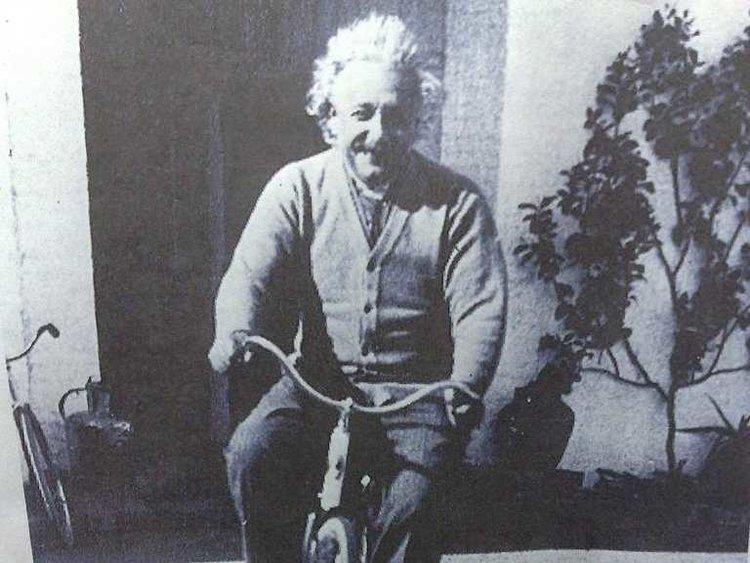
On authority
(Flickr/jeffmcneill)
"Unthinking respect for authority is the greatest enemy of truth."
["The Curious History of Relativity"]
1.1 MODERN PHYSICS
The dream of every theoretical physicist is to find mathematical relationships translated into physical laws, which govern al natural phenomena without distinction.
In reality, nature has a very bizarre behavior.It is composed by infinitesimal disordered particles that, on the whole, create an amazing order.
A water molecule is made up of an infinity of infinitesimal elements (atoms, protons, neutrons, electrons, quarks, ...) joined together to form, for example, even "the sea; it shows us an order, an unprecedented beauty and elegance.
Although modern physics has achieved a condition of modeling physical phenomena which is without paral els, many physicists are stil working to formulate a unified theory that includes both the study of the infinitely small (quantum physics) and the study of gravity or the infinitely large (Relativity theory).
Next pageFont size:
Interval:
Bookmark:
Similar books «THE MARVELOUS THEORY OF SPECIAL AND GENERAL RELATIVITY»
Look at similar books to THE MARVELOUS THEORY OF SPECIAL AND GENERAL RELATIVITY. We have selected literature similar in name and meaning in the hope of providing readers with more options to find new, interesting, not yet read works.
Discussion, reviews of the book THE MARVELOUS THEORY OF SPECIAL AND GENERAL RELATIVITY and just readers' own opinions. Leave your comments, write what you think about the work, its meaning or the main characters. Specify what exactly you liked and what you didn't like, and why you think so.

